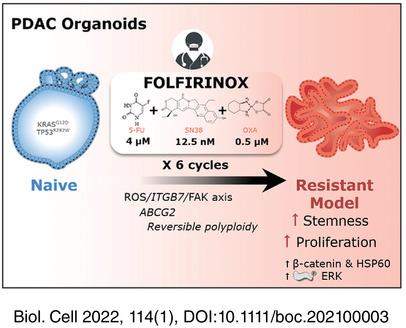A new pancreatic adenocarcinoma-derived organoid model of acquired chemoresistance to FOLFIRINOX: First insight of the underlying mechanisms
Abstract
Background Information
Although improvements have been made in the management of pancreatic adenocarcinoma (PDAC) during the past 20 years, the prognosis of this deadly disease remains poor with an overall 5-year survival under 10%. Treatment with FOLFIRINOX, a combined regimen of 5-fluorouracil, irinotecan (SN-38) and oxaliplatin, is nonetheless associated with an excellent initial tumour response and its use has allowed numerous patients to go through surgery while their tumour was initially considered unresectable. These discrepancies between initial tumour response and very low long-term survival are the consequences of rapidly acquired chemoresistance and represent a major therapeutic frontier. To our knowledge, a model of resistance to the combined three drugs has never been described due to the difficulty of modelling the FOLFIRINOX protocol both in vitro and in vivo. Patient-derived tumour organoids (PDO) are the missing link that has long been lacking in the wide range of epithelial cancer models between 2D adherent cultures and in vivo xenografts. In this work we sought to set up a model of PDO with resistance to FOLFIRINOX regimen that we could compare to the paired naive PDO.
Results
We first extrapolated physiological concentrations of the three drugs using previous pharmacodynamics studies and bi-compartmental elimination models of oxaliplatin and SN-38. We then treated PaTa-1818x naive PDAC organoids with six cycles of 72 h-FOLFIRINOX treatment followed by 96 h interruption. Thereafter, we systematically compared treated organoids to PaTa-1818x naive organoids in terms of growth, proliferation, viability and expression of genes involved in cancer stemness and aggressiveness.
Conclusions
We reproductively obtained resistant organoids FoxR that significantly showed less sensitivity to FOLFORINOX treatment than the PaTa-1818x naive organoids from which they were derived. Our resistant model is representative of the sequential steps of chemoresistance observed in patients in terms of growth arrest (proliferation blockade), residual disease (cell quiescence/dormancy) and relapse.
Significance
To our knowledge, this is the first genuine in vitro model of resistance to the three drugs in combined therapy. This new PDO model will be a great asset for the discovery of acquired chemoresistance mechanisms, knowledge that is mandatory before offering new therapeutic strategies for pancreatic cancer.


 求助内容:
求助内容: 应助结果提醒方式:
应助结果提醒方式:


